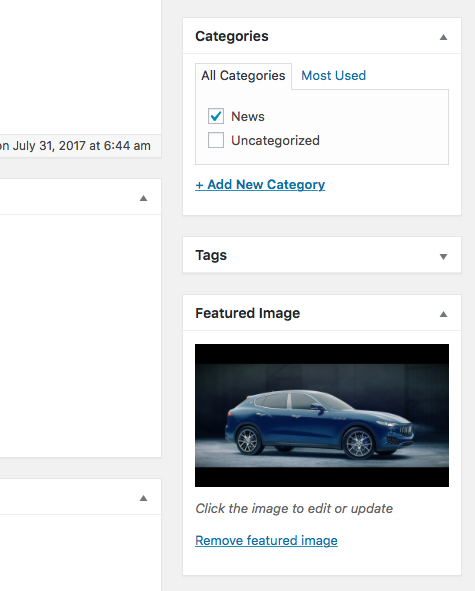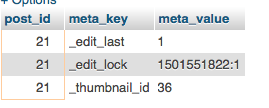最近项目需要,分析了一下Wordpress的特色图像 Feature Image的上传、保存方式,这一分析觉得Wordpress的数据结构设计还真是有想法。
先简单说一下结论:
Wordpress中图像物理文件保存在
wp-content/uploads目录下,相关信息保存在 wp_posts 表中。post_type 是 attachment,post-mime-type 是 image/png。通过 post_parent 与文章关联。
我原来以为图片信息会有单独的表存放,没想到都放在 wp_posts 中,于是分析了这样做有什么好处。
wp_posts 表
首先来看看 wp_posts 表。该表用来存放文章信息,如文章标题、正文、摘要、作者、发布时间、访问密码、评论数、修改时间、文章地址(非静态化之前的,带?和数字ID)等。这些属性都是与文章相关的,同时根据 post_type的不同,该表还能用来存储特色图像 Featured Image。
| 字段 | 含义 |
|---|---|
| ID | 自增唯一ID |
| post_author | 对应作者ID |
| post_date | 发布时间 |
| post_date_gmt | 发布时间(GMT+0时间) |
| post_content | 正文 |
| post_title | 标题 |
| post_excerpt | 摘录 |
| post_status | 文章状态(publish |
| comment_status | 评论状态(open |
| ping_status | PING/Trackback状态(open/closed) |
| post_password | 文章密码 |
| post_name | 文章缩略名 |
| to_ping | 要引用的URL链接 |
| pinged | 已经PING过的链接 |
| post_modified | 修改时间 |
| post_modified_gmt | 修改时间(GMT+0时间) |
| post_content_filtered | 未知 |
| post_parent | 父文章,主要用于PAGE |
| guid | 文章的一个链接。注意:不能将GUID作为永久链接(虽然在2.5之前的版本中它的确被当作永久链接),也不能将它作为文章的可用链接。GUID是一种独有的标识符,只是目前恰巧成为文章的一个链接。 |
| menu_order | 排序ID |
| post_type | 文章类型(post/page/attachment/revision等) |
| post_mime_type | MIME类型 |
| comment_count | 评论总数 |
由此可以看到,Wordpress 利用 post_type 可以在该表中存储草稿、文章、页面、附件等丰富的信息,一张表就搞定了。
wp_postmeta 表
与这张表相关联的,还有一个 wp_postmeta 表,用来存储与文章相关的元数据。这个表的表结构比较简单。
| 字段 | 含义 |
|---|---|
| meta_id | 元数据记录的ID。 |
| post_id | 就是元数据相关联的post,用户(user),评论(comment)的ID。 |
| meta_key | 元键(meta key)(这个值在不同的记录中经常是重复的)。 |
| meta_value | 元值(meta value)(往往是唯一的)。 |
如何获取特色图像 Featured Image
那么,对于一个文章,是如何来获取特色图像 Featured Image的,下面来看一下。在后台的文章编辑界面,特色图像显示在这个位置。

对应的后台代码是 wp-admin/includes/meta-boxes.php
/**
* Display post thumbnail meta box.
*
* @since 2.9.0
*
* @param WP_Post $post A post object.
*/
function post_thumbnail_meta_box( $post ) {
$thumbnail_id = get_post_meta( $post->ID, '_thumbnail_id', true ); //获取特色图像对应的ID
echo _wp_post_thumbnail_html( $thumbnail_id, $post->ID ); //输出HTML
}
继续找 get_post_meta ,在wp-includes/post.php中。
/**
* Retrieve post meta field for a post.
*
* @since 1.5.0
*
* @param int $post_id Post ID.
* @param string $key Optional. The meta key to retrieve. By default, returns
* data for all keys. Default empty.
* @param bool $single Optional. Whether to return a single value. Default false.
* @return mixed Will be an array if $single is false. Will be value of meta data
* field if $single is true.
*/
function get_post_meta( $post_id, $key = '', $single = false ) {
return get_metadata('post', $post_id, $key, $single);
}
继续找 get_metadata 在 wp-includes/meta.php 中。
/**
* Retrieve metadata for the specified object.
*
* @since 2.9.0
*
* @param string $meta_type Type of object metadata is for (e.g., comment, post, or user)
* @param int $object_id ID of the object metadata is for
* @param string $meta_key Optional. Metadata key. If not specified, retrieve all metadata for
* the specified object.
* @param bool $single Optional, default is false.
* If true, return only the first value of the specified meta_key.
* This parameter has no effect if meta_key is not specified.
* @return mixed Single metadata value, or array of values
*/
function get_metadata($meta_type, $object_id, $meta_key = '', $single = false) {
if ( ! $meta_type || ! is_numeric( $object_id ) ) {
return false;
}
$object_id = absint( $object_id );
if ( ! $object_id ) {
return false;
}
//echo $object_id . ':' . $meta_type . '-' . $meta_key . '-' . $single . '<br />';
/**
* Filters whether to retrieve metadata of a specific type.
*
* The dynamic portion of the hook, `$meta_type`, refers to the meta
* object type (comment, post, or user). Returning a non-null value
* will effectively short-circuit the function.
*
* @since 3.1.0
*
* @param null|array|string $value The value get_metadata() should return - a single metadata value,
* or an array of values.
* @param int $object_id Object ID.
* @param string $meta_key Meta key.
* @param bool $single Whether to return only the first value of the specified $meta_key.
*/
$check = apply_filters( "get_{$meta_type}_metadata", null, $object_id, $meta_key, $single );
if ( null !== $check ) {
if ( $single && is_array( $check ) )
return $check[0];
else
return $check;
}
$meta_cache = wp_cache_get($object_id, $meta_type . '_meta');
if ( !$meta_cache ) {
$meta_cache = update_meta_cache( $meta_type, array( $object_id ) );
$meta_cache = $meta_cache[$object_id];
}
if ( ! $meta_key ) {
return $meta_cache;
}
if ( isset($meta_cache[$meta_key]) ) {
if ( $single )
return maybe_unserialize( $meta_cache[$meta_key][0] );
else
return array_map('maybe_unserialize', $meta_cache[$meta_key]);
}
if ($single)
return '';
else
return array();
}
这个函数中会根据 $meta_key 和 $object_id 、$meta_type 取出特色图像对应的ID。为了避免重复读取数据库,这里用了缓存,我们可以看 update_meta_cache 这个函数。
/**
* Update the metadata cache for the specified objects.
*
* @since 2.9.0
*
* @global wpdb $wpdb WordPress database abstraction object.
*
* @param string $meta_type Type of object metadata is for (e.g., comment, post, or user)
* @param int|array $object_ids Array or comma delimited list of object IDs to update cache for
* @return array|false Metadata cache for the specified objects, or false on failure.
*/
function update_meta_cache($meta_type, $object_ids) {
global $wpdb;
if ( ! $meta_type || ! $object_ids ) {
return false;
}
$table = _get_meta_table( $meta_type );
if ( ! $table ) {
return false;
}
$column = sanitize_key($meta_type . '_id');
if ( !is_array($object_ids) ) {
$object_ids = preg_replace('|[^0-9,]|', '', $object_ids);
$object_ids = explode(',', $object_ids);
}
$object_ids = array_map('intval', $object_ids);
$cache_key = $meta_type . '_meta';
$ids = array();
$cache = array();
foreach ( $object_ids as $id ) {
$cached_object = wp_cache_get( $id, $cache_key );
if ( false === $cached_object )
$ids[] = $id;
else
$cache[$id] = $cached_object;
}
if ( empty( $ids ) )
return $cache;
// Get meta info
$id_list = join( ',', $ids );
$id_column = 'user' == $meta_type ? 'umeta_id' : 'meta_id';
echo "SELECT $column, meta_key, meta_value FROM $table WHERE $column IN ($id_list) ORDER BY $id_column ASC" . "<br />";
$meta_list = $wpdb->get_results( "SELECT $column, meta_key, meta_value FROM $table WHERE $column IN ($id_list) ORDER BY $id_column ASC", ARRAY_A );
if ( !empty($meta_list) ) {
foreach ( $meta_list as $metarow) {
$mpid = intval($metarow[$column]);
$mkey = $metarow['meta_key'];
$mval = $metarow['meta_value'];
// Force subkeys to be array type:
if ( !isset($cache[$mpid]) || !is_array($cache[$mpid]) )
$cache[$mpid] = array();
if ( !isset($cache[$mpid][$mkey]) || !is_array($cache[$mpid][$mkey]) )
$cache[$mpid][$mkey] = array();
// Add a value to the current pid/key:
$cache[$mpid][$mkey][] = $mval;
}
}
foreach ( $ids as $id ) {
if ( ! isset($cache[$id]) )
$cache[$id] = array();
wp_cache_add( $id, $cache[$id], $cache_key );
}
return $cache;
}
关键的语句在这里
SELECT post_id, meta_key, meta_value FROM wp_postmeta WHERE post_id IN (21) ORDER BY meta_id ASC
可以看到结果如下,_thumbnail_id 对应的就是 wp_posts 中的记录ID,从而可以取到图片对应的地址和相关信息。

本文内容基于 Wordpress 4.8版本
参考资料:
1、如何设置Wordpress的特色图像
2、WordPress数据库表及字段详解
3、理解和利用 WordPress 中的元数据(Metadata)